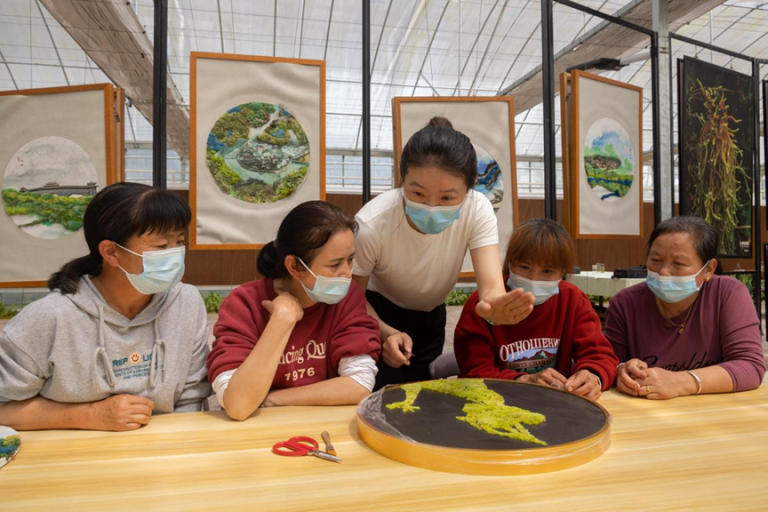China’s Ministry of Culture and Tourism and five other departments recently issued a
guideline on promoting the development of cultural industries in a bid to advance rural
vitalization, with traditional handcrafts listed as one of the seven key fields that can help
boost rural vitalization.
Rural vitalization cannot be achieved without the formation and development of a new type of
relations between urban and rural areas.
China’s urbanization process, during which resources and population have crowded into
megacities, has seen a break point of counter-urbanization on its journey toward a moderately
prosperous society in all respects. A development pattern featuring urban areas’ dependence
on and support for rural areas and urban-rural integration has been gradually formed.
The resurgence and revitalization of traditional handcraft in rural areas couldn’t have been
possible without such a macroscopic social development pattern.
Heqing county in southwest China’s Yunnan province, and villages under its administration
give a good example of the point.
The resurgence and revitalization of metal craft in Heqing has undergone four stages. The
first stage came at the beginning of China’s reform and opening-up, when a large batch of
tinkers left their hometown Heqing to work in big cities, and learned skills and accumulated
capital. In the mid-to-late 1990s, they returned home to start their own businesses, and Xinhua
village in the county gradually earned fame because of local silverware. After 2010, Heqing
entered the third stage, when it started to exploit China’s teaware market besides the artware
market. Since 2019, the county has attracted and gathered a group of creative people and
developed cultural tourism, which signifies the fourth stage.
It can be seen that during the first and second stages, Heqing was mainly developing
manufacturing, a development model similar to that of rural industry since the reform and
opening-up, except that the former focused on traditional handcraft and the latter modern
industry.
After entering the third and fourth stages, the county witnessed a shift of focus in
development from rural handcraft industry to high value-added cultural tourism, with new
business forms and features similar to those in Jingdezhen city, east China’s Jiangxi province,
Yixing city, east China’s Jiangsu province, and Longquan city, east China’s Zhejiang
province, all frontrunners in integrating local culture and tourism.
Such a change is in accord with China’s policy on intangible cultural heritage protection and
social development concepts, and was facilitated by Heqing’s unique advantages in
geographical and transportation conditions. The county, which is endowed with spectacular
scenery, is situated along a popular tourist route between the Dali Old Town and the Old
Town of Lijiang, two well-known tourist destinations in Yunnan, and is 20 minutes’ drive
away from Lijiang Sanyi International Airport.
Heqing is, therefore, not only able to communicate more easily with other regions on the
production of silver and bronze ware, but enjoys favorable conditions in drawing creative
talents, running homestay business and promoting out all-for-one tourism.
The transformation and upgrading of rural handcraft industry has been guaranteed by the
popularization of the ideas of intangible cultural heritage protection and “lucid waters and
lush mountains are invaluable assets”, as well as a series of related natural and cultural
ecological protection policies.
China has established national eco-cultural protection zones since 2007, and vigorously
advanced the construction of cultural belts, national parks and national cultural parks in recent
years, creating a good environment for the inheritance of intangible cultural heritage and
preservation of traditional villages.
Intangible cultural heritage inheritance relies on the overall environment and audience as well
as on core inheritors, especially the younger generation of inheritors.
Since 2015, the government has made great efforts to implement a training program to
cultivate and enhance the inheritance and innovation capabilities of the new generation of
intangible cultural heritage inheritors.
In 2016, it began to set up traditional craft work stations to introduce high-quality art design
resources into regions with traditional crafts and underdeveloped areas. On the basis of these
work stations, it has promoted the establishment of a good number of intangible cultural
heritage workshops for poverty alleviation, driving rural residents to make innovations and
start businesses to march toward prosperity.
During the process, a host of young and capable traditional craft inheritors and promoters
have emerged.
By introducing design teams and commercial orders, a traditional craft work station in Hami
city, northwest China’s Xinjiang Uygur autonomous region, which is committed to
revitalizing Uygur embroidery, has established a handcraft industry cooperation system that
links the vast rural areas in the city. Thanks to the system, many villagers went to big cities
including Beijing to share and learn skills.
Kader Rehman, a member of the work station, has grown from a skillful embroiderer to a
pattern designer and the work station’s liaison to customers, bringing a stream of orders to his
hometown.
In Qiandongnan Miao and Dong autonomous prefecture, southwest China’s Guizhou
province, intangible cultural heritage inheritors of various ethnic groups have greatly
benefited from the training program, traditional craft work stations and intangible cultural
heritage workshops for poverty alleviation.
Yang Xiufang, an inheritor of Miao batik in the prefecture, sharpened her skills at Tsinghua
University under the training program in 2016. After that, she returned to her hometown in a
mountainous area and has led a group of Miao women in the production of handcrafts using
the batik technique.
With the popularization of education and improvement in transportation and communication
conditions, more and more rural craftspeople have strengthened communication with the
outside world, carrying out cooperation with universities, participating in exhibitions and
hosting livestreaming shows.
Besides, many college graduates have chosen to return to their hometown in the countryside
to start businesses. They have become the new generation of inheritors or designers and
managers, helping fill the gaps in the local industrial chain.



